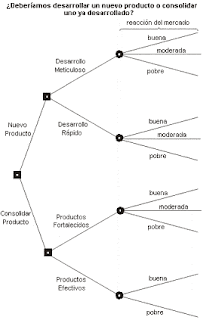 In recent decades the world has seen many changes ranging from the consolidation of the globalization of markets to the continuing revolution in information technology and communication.
In recent decades the world has seen many changes ranging from the consolidation of the globalization of markets to the continuing revolution in information technology and communication. Today, taking into account global and competitive environment, managers need to gather more data before making decisions. All successful programs have in common principle: measure and continue to measure, just so they can improve their game. In this new way of thinking is required to be competitive and we were more interested in the little things that make our internal customers.
A major task of management is to optimize the utilization of resources available for achieve the objectives of the organization, work begins with the decision making process, which fall into three categories: strategic, administrative and operational.
test
The strategic decisions , that is, relevant to the direction of the company's long-term deal mainly with issues related to the selection of the mix of products and services, their markets and way to address them. The key questions are: what are the objectives and goals of the company and what strategy to achieve them? Should the company seek diversification? In what areas? How vigorously? How should develop and exploit the current position of the product on the market. "
making "strategic" does not necessarily mean "important." There are major operational decisions that some strategic. The
administrative decisions have to do with structuring the firm's resources in such a way that creates the greatest potential for implementation. They have to do with the structure of authority and relationship responsibilities, workflow, media location, acquisition and development of resources, staff development and training and financing and acquisition of equipment among others. It is true that the structure follows strategy, but the strategy requires the structure among other things, organizing the administration of the company so as to achieve a proper balance of resource allocation to support the strategic and operational decisions.
The operational decisions absorb the bulk of the energy and attention of management. Its objective is to maximize the profits of the operation. The main decision areas are: resource allocation (budget), schedule the operation, performance monitoring and implementation of control measures.
- empathize with the change.
- Creating better conditions for competition.
- Produce better and lower cost.
- offer better services in both the private and public, in order to inculcate and deepen the country a culture of quality that you put it up to the most attractive markets in the world.
is also necessary to fully reform training programs for employees, as this occurs in most organizations poorly and favoritism. The company must not fail to consider that the money was spent on this training, education and training, not increase the net worth of the company, but if it leads to improvements in all operational and management processes are made.
 The formal definition of the objectives is one of the most important requirements. Without quality objectives there is no goal to reach, the system freezes, there is no improvement and are not shown if you are doing well. There are two types of quality objectives, which serve quality control and serving to improve quality.
The formal definition of the objectives is one of the most important requirements. Without quality objectives there is no goal to reach, the system freezes, there is no improvement and are not shown if you are doing well. There are two types of quality objectives, which serve quality control and serving to improve quality.
Although management is responsible for planning and setting goals to be achieved the full participation of all personnel of the company for the purpose of engaging them to achieve these objectives. Always remember that there is no compromise without participation. The strategy of Total Quality Management under the aims to:
- know and meet customer needs. Achieving
- keep customers and attract new customers.
- Improve company image and enhance their implementation.
2. ECONOMIC
- Reduce costs.
- Increase profits.
- Increase competitiveness.
- Streamline processes.
- Betting on prevention and continuous improvement.
- Research and provision of new technologies.
- increase and channel information and training.
- Enhance initiative and responsibility.
- Engaging and involving all departments.
- Achieving customer satisfaction.
- Involvement and unconditional support of the Directorate.
- personal involvement and cooperation.
- Continuous improvement and innovation.
- Lifelong learning.
- 0 Defects: Full production quality.
- 0 Damage: Maximum performance of facilities.
- 0 Stocks: Minimum fixed capital.
- 0 Delays: JIT.
- 0 Paper: useless. Maximum administrative efficiency.
KEY ELEMENTS OF TOTAL QUALITY
Success the implementation of Total Quality, by implementing some key elements:
- Decision and management leadership.
- Accession all staff.
- Meet all expectations of customers efficiently.
- Ruling processes through continuous improvement.
PILLARS OF QUALITY
- UNE-EN-ISO 9000.
- EFQM European Award.
- Malcolm Baldridge Award.
- Statistical methods.
- Rules and Regulations.
- control methods and improvement.
- Research and Evaluation.
- Management.
- Administrative and technical.
- all staff in general.
- internal and external customers.
- The Management.
- Organization.
- Staff.
- The strategy and tactics.






















